After keeping quiet about the progress of its central bank digital currency (CBDC) pilot for a year, the People’s Bank of China has now reported digital RMB volumes for two consecutive months. The cumulative figure to the end of June was RMB 7 trillion ($988 billion), up from RMB 6.6 trillion ($932 bn) at the end of May. That’s equivalent to $56 billion in a month.
While many envision using a CBDC for payments at the grocery or restaurants, the digital RMB is also used for high value corporate transactions, including cross border ones. Plus, state owned companies make salary payments with the eCNY. Without the figure for the number of transactions, it’s hard to tell the current average transaction value. That figure rose almost seven fold between 2022 and 2023 to RMB 1,895 ($267).

During a press conference earlier this week, Lu Lei, Deputy Governor of the People’s Bank of China, outlined some of the next steps for the eCNY. A key one is to make it more compatible with the digital economy.
So far the pilot has rolled out in 17 provinces. Current goals include making it more accessible for the elderly, broadening the range of smart contracts, expanding the number of retail outlets and making it more convenient to use. They also want to make it easier to use for foreign visitors to the mainland.
Mr Lu briefly touched on China’s involvement in mBridge, the wholesale CBDC solution for cross border payments, which is currently at the minimum viable product (MVP) stage. The BIS Innovation Hub in Hong Kong leads the project, with five central banks involved.
While mBridge is a multilateral connectivity project, Mr Lu observed the central bank is also happy to promote interconnections bilaterally. In fact, it already has. One of the partners in mBridge is the UAE. Before mBridge reached the MVP stage, China paid for a crude oil shipment using the eCNY.






